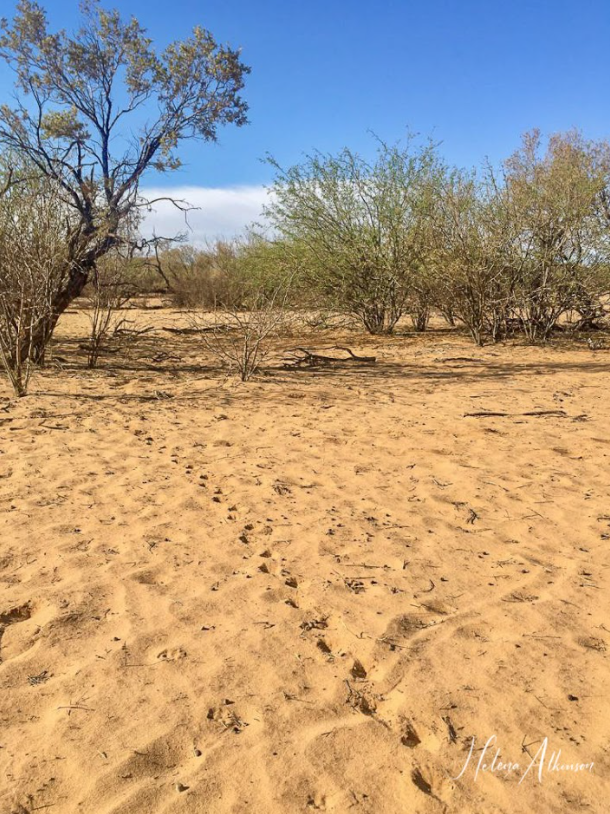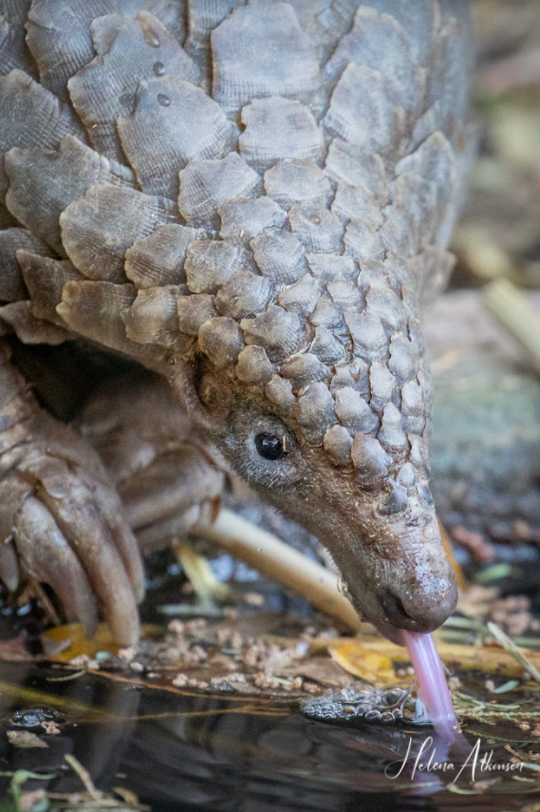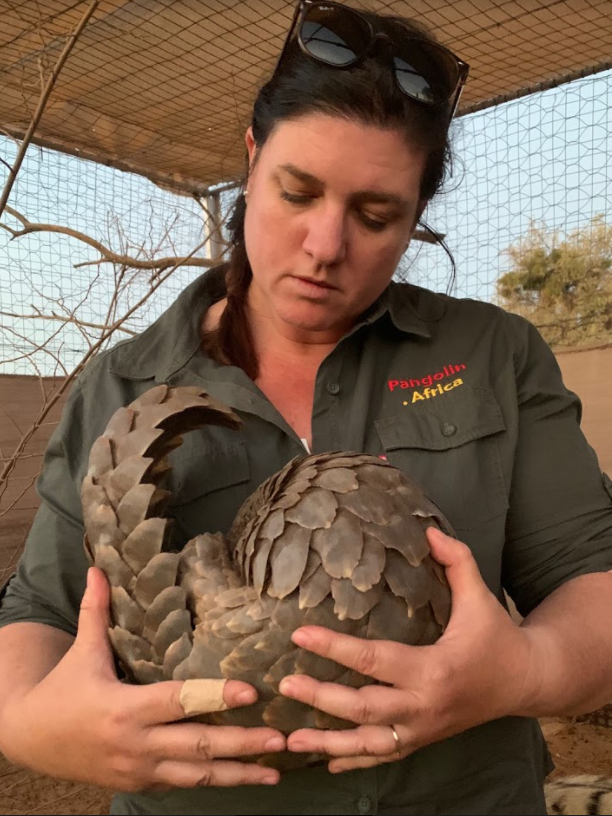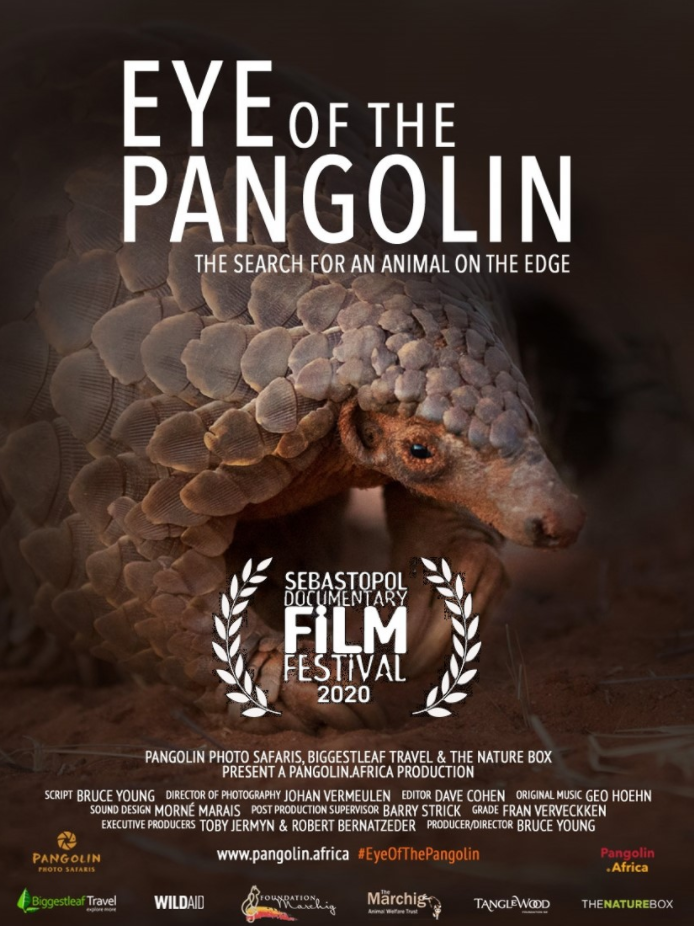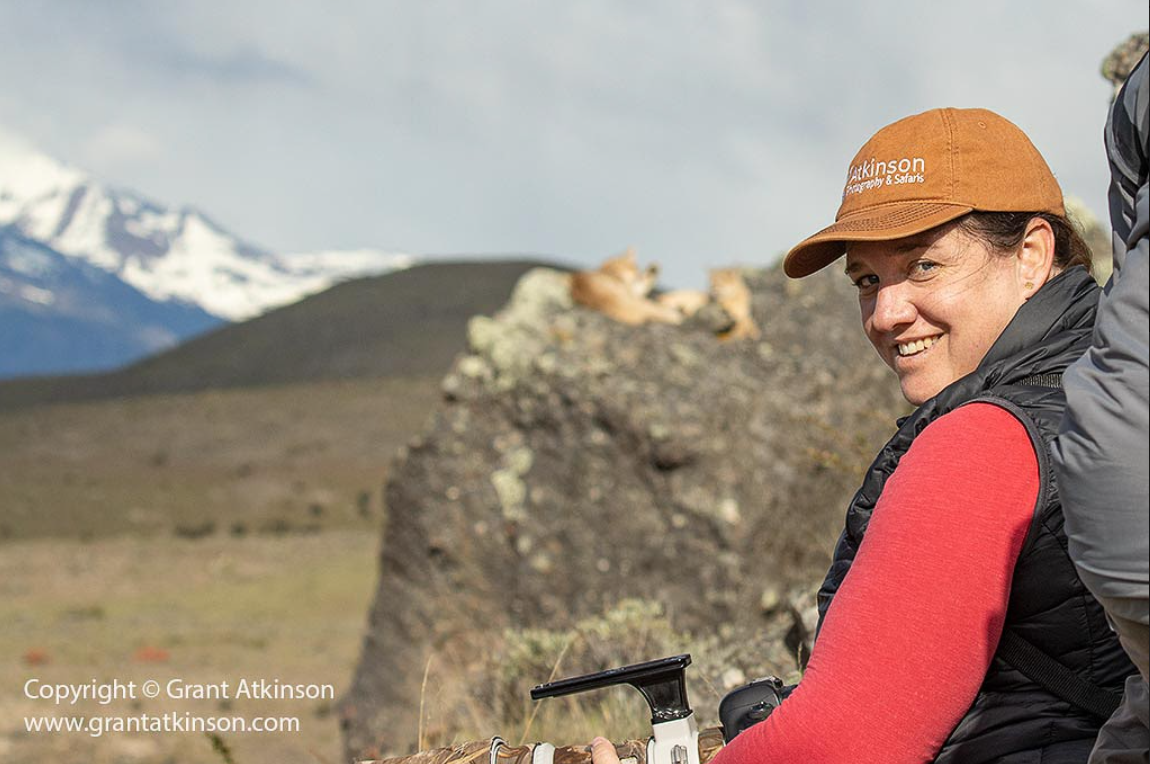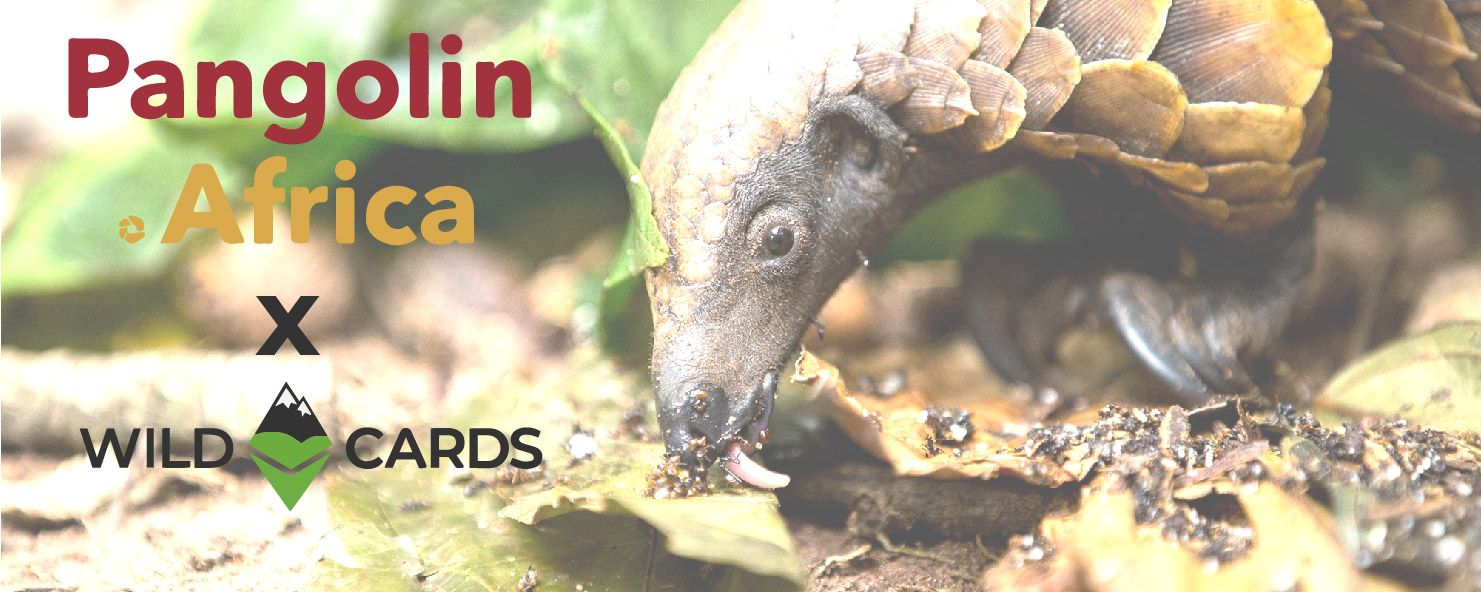What wild animal leaves teddy bear footprints behind?
Rio Button
February 07, 2022 · 9 min read
Photo by Helena Atkinson.
Here are some clues…
- Using their sticky tongues, which are longer than their bodies, these animals slurp up their favourite snack — ants — but they will sometimes eat termites too.
- They plod along the ground on their two back legs at night and sleep huddled in underground burrows during the day.
- These gentle scaly creatures roll up into a nearly impenetrable roly-poly ball when frightened.
- Even though their habitat extends from Southern to East Africa, they are very elusive and you’d be extremely lucky to ever see one.
A scared Temminck’s pangolin in a roly-poly ball. Photo by Helena Atkinson.
If you haven’t guessed what they are yet, don’t fret. They’re pangolins, specifically Temminck’s pangolins or Ground pangolins. Pangolins in general have a great deal to be frightened about, as these “walking pine cones” are the most traffic/poached mammal on earth. It is thought that they could become extinct before most people realised they ever existed at all.
A Temminck’s pangolin looking for snacks. Photo by Helena Atkinson.
Looking for teddy bear footprints
Helena Atkinson, a conservation biologist from Pangolin.Africa, a non-profit dedicated to pangolin protection, tells me about the first time she went looking for the elusive Temminck’s pangolin, the only species of pangolin found in South Africa. She was told that their footprints looked like someone took a teddy bear and used their feet to make tracks in the sand. “Once you’ve seen the tracks, you actually can’t get it out of your head because that’s actually exactly what they look like!” Helena tells me. “They walk on their back legs, most of the time, with their tail hovering above the ground, not dragging it, and with their front paws kind of held up. They look a bit funny when they walk but they can actually walk quite fast when they want to.”
A Temminck’s pangolin. Photo by Grant Atkinson.
A footprint of a Temminck’s pangolin. Photo by Helena Atkinson.
“The actual animal is so incredible and charismatic. It’s hard to be around them, engage with them, work with them, and not be completely touched and moved by their psyche and personalities,” Helena explains. “They have incredibly perceptive eyes - eyes that you feel are really observing you and watching you and you can see they have intelligent thoughts,” she tells me. With her background in conservation, especially the non-profit sector, Helena helped get Pangolin.Africa off the ground and has been involved ever since. Pangolin.Africa coordinates and fundraises for pangolin protection, rehabilitation, rewilding and education projects all over Africa and was registered as a non-profit organisation in 2018.
A Temminck’s pangolin slurping up some water. Photo by Helena Atkinson.
Helena has worked rehabilitating scared injured rescued pangolins and in some cases managed to earn their trust. Sensing they trust her, makes her feel responsible for them and their future as a species. “It’s an animal that touches you and you can’t help but feel like it’s the most unfair thing in the world for them to be taken from the wild. They really don’t survive captivity,” she tells me. We have to combat the pangolin illegal wildlife trade, rescue pangolins from the trade and protect them in the wild, because we can’t breed them in captivity, she says.
Photo of Helena Atkinson with a pangolin that was taken from the illegal wildlife trade. It is one of the lucky ones that was rescued, treated, and eventually released.
Why’s there such a demand for pangolins?
The illegal wildlife trade of pangolins stems from the demand for their scales in traditional medicine. These timid creatures scales are believed to help women lactate as well as cure cancers and blood diseases. Like rhino horn pangolin scales are made from keratin, the same stuff your fingernails and hair is made from and there is no scientific evidence to back up its traditional medical claims. However, the illegal wildlife trade is not all these walking pinecones have to fear…
The trouble with electric fences
Between 436 and 1,190 pangolins die from being accidentally electrocuted by electric fences every year in Southern Africa, according to Pangolin.Africa. Since we don’t have reliable estimates on how big the population is or how many are removed by the illegal wildlife trade, it’s essential to do all we can to protect and rescue the pangolins we can. Pangolin.Africa has started a pangolin-friendly farm fence project working with landowners and electric fence companies to modify existing fences to reduce their impact on pangolins. The modifications entail making the bottom two strands of the fence -where pangolins generally get stuck- switch off when resistance in the fence is detected. While leaving the top part of the fence live, thus ensuring that the basic functionality of the fence is maintained.
Pangolin rehabilitation is intensive and slow
Pangolins rescued from electric fences and the illegal wildlife trade are rehabilitated by a network of rehabilitation centres. Pangolin.Africa helps facilitate and fund one in the Northern Cape. “Pangolins are a mystery in many ways,” Helena explains. We know very little about them and there has been extensive collaboration to develop best practices for rehabilitating them. Successful rehabilitation is a slow and intensive process. Pangolins coming from the illegal wildlife trade are often traumatised, dehydrated, starving, and sick, due to their immune systems having been compromised. During rehabilitation, pangolins sleep indoors and must be taken out every day to forage, as they mainly eat live ants and termites that live in the ground. Once they have recovered physically and can forage on their own, they are fitted with a tracking device and released into suitable and safe wild areas. Each pangolin released is monitored closely and weighed regularly, because even a small decrease in weight is often a sign of grave health issues. We need to ensure the survival of every pangolin we can, Helena tells me.
A Temminck’s pangolin heading back to its burrow after a night of foraging. You can see its tracking device attached near the base of its tail. Photo by Johan Vermeulen.
Educating rural children
Helena knows that to ensure the survival of these gentle creatures into perpetuity educating people is essential, especially those living in areas where poaching pangolins may perhaps be a community livelihood or cultural practice. Pangolin.Africa has an intensive educational campaign, which includes showing rural children in Africa an 8-minute version of their film “Eye of the Pangolin”. This moving and powerful film is about the critical situation facing pangolins in Africa.
More about Helena
Helena always knew when she grew up that she wanted to work in nature conservation. At ten years old Helena remembers doing a, “What do you want to be when you grow up?” school oral about becoming a game ranger. Her passion for wildlife led her to complete her master’s degree, in conservation, where she investigated conflict between protected areas and local communities. Now with over a decade of experience in conservation in everything from education, tourism, management, stakeholder engagement, photography and more. This experience and her genuine care for both wildlife and people have enabled her to use conservation as a poverty alleviation tool to achieve sustainable community development. For sustainable projects, she knows community buy-in is essential and that environmental education can increase communities positivity and receptiveness to conservation. She is a member of the IUCN SSC Pangolin Specialist Group and divides her time between pangolin conservation projects and leading wildlife photographic safaris.
Helena Atkinson leading a photographic safari. Photo by her husband Grant Atkinson.
Pangolin.Africa partners with Wildcards!
To raise funds for Pangolin.Africa the Pendo wildcard was launched! This wildcard has already raised more than 1500 USD (over R20 000) for Pangolin.Africa. Each wildcard has a captivating, fact-filled story about an individual animal, a conservation organisation like Pangolin.Africa helps protect. You can publicly buy one of these Wildcards online, which will make you the guardian of that Wildcard animal. When you buy a Wildcard, you must set the price you are willing to sell it for. Every month, as the guardian of a Wildcard, you will give a specified portion of the selling price you set, to that animal’s representative conservation agency, in this case, Pangolin.Africa. At any point, someone can buy the Wildcard from you, at the selling price you specified. When someone buys the Wildcard from you, they must set a selling price. The new guardian of the Wildcard is then responsible for giving the new monthly subscription. And so the cycle continues, to generate funds.
Wildcards is ecstatic about connecting funders with conservation agencies having a real-world impact on the protection of wild animals and rewilding the world.
Follow Wildcards on Instagram: @wildcards_world
Follow Wildcards on Twitter: @wildcards_world
Follow Wildcards on Facebook: @wildcards.conservation
Join Wildcards on: Discord
Written by Wildcards resident conservation biologist Rio Button.
Dr Seahorse’s journey
From unravelling seahorses’ secret sounds to safeguarding the habitat of these little super dads. St...
Rio Button
June 29, 2022 · 5 min read
What wild animal leaves teddy bear footprints behind?
Photo by Helena Atkinson. Photo by Helena Atkinson. Here are some clues… Using their sticky tongues,...
Rio Button
February 07, 2022 · 9 min read
Tech innovation: Solving wildlife conservation's greatest challenge
Tech start-up Wildcards has raised over 130,000 USD for conservation organisations around the world ...
Rio Button
August 24, 2021 · 7 min read
Curious creatures under persecution
From having a deep fear of sharks to defending them. Reluctant, Grant Smith tumbled backwards off t...
Rio Button
July 26, 2021 · 8 min read
NFT Postcards for a purpose
NFT Postcards for a purpose A limited edition set of NFTs has been created in partnership with the T...
Jason Smythe
April 01, 2021 · 2 min read
Do you Care for Wild?
As rhino poaching soars, what happens to the orphaned rhino calves left behind? An orphaned baby bla...
Rio Button
February 24, 2021 · 7 min read
Where the wild things roam
South Africa’s most Endangered carnivore can’t be kept in by fences. Wildcards chatted to the man re...
Rio Button
February 23, 2021 · 10 min read
Rumours of an elusive feline in the mangrove forest
While collecting data in San Pedro de Vice Mangroves, in the Sechura desert, final year biology stud...
Rio Button
December 23, 2020 · 8 min read
South Africa’s last remaining white shark stronghold under threat
The Oceans Research Institute battles the impact of demersal longline fishing to safeguard great whi...
Rio Button
November 25, 2020 · 8 min read
Malaysia has marine mammals?
90% of Malaysians don’t know there are dolphins and whales in Malaysian waters There are at least 6 ...
Rio Button
November 17, 2020 · 9 min read

